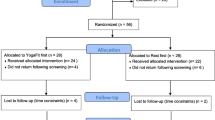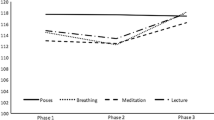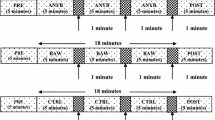Abstract
This study explores the physiological correlates of a highly practiced Kundalini Yoga meditator. Thoracic and abdominal breathing patterns, heart rate (HR), occipital parietal electroencephalograph (EEG), skin conductance level (SCL), and blood volume pulse (BVP) were monitored during prebaseline, meditation, and postbaseline periods. Visual analyses of the data showed a decrease in respiration rate during the meditation from a mean of 11 breaths/min for the pre- and 13 breaths/min for the postbaseline to a mean of 5 breaths/min during the meditation, with a predominance of abdominal/diaphragmatic breathing. There was also more alpha EEG activity during the meditation (M = 1.71 μV) compared to the pre- (M = .47 μV) and postbaseline (M = .78 μV) periods, and an increase in theta EEG activity immediately following the meditation (M = .62 μV) compared to the pre-baseline and meditative periods (each with M = .26 μV). These findings suggest that a shift in breathing patterns may contribute to the development of alpha EEG, and those patterns need to be investigated further.
Similar content being viewed by others
REFERENCES
Anad, B. K., China, G. S., & Singh, B. (1961). Some aspects of electroencephalographic studies in yoga. Electroencephalography and Clinical Neurophysiology, 13, 452-456.
Bagchi, B. K., & Wegner, M. A. (1957). Electrophysiological correlates of some yogi exercises. Electroencephalography and Clinical Neurophysiology, 7, 132-149.
Becker, D. E., & Shapiro, D. (1981). Physiological responses to clicks during zen, yoga, and TM meditation. Psychophysiology, 18(6), 694-699.
Corby, J. C., Roth, W. T., Zarcone Jr, V. P., & Kopell, B. S. (1978). Psychophysiological correlates of tantric yoga meditation. Archives of General Psychiatry, 35, 571-577.
Cusumano, J. A., & Robinson, S. E. (1992). The short term psychophysiological effects of hatha yoga and progressive relaxation on female Japanese students. Applied Psychology: An International Review, 42(1), 77-90.
Das, N. N., & Gastaut, H. (1957). Variations de l'activite electrique du cerveau du coeur et des muscles quelletiques au cours de la meditation et de l'extase yogique. Electroencephalgraphy and Clinical Neurophysiology, 6, 211-219.
Delmonte, M. M. (1984a). Electrocortical activity and related phenomena associated with meditation practice: A literature Review. International Journal of Neurosciences, 24, 217-231.
Delmonte, M. M. (1984b). Physiological concomitants of meditation practice. International Journal of Psychosomatics, 31(4), 23-26.
DiCarlo, L. J., Sparling, P. B., Hinson, B. T., Snow, T. K., & Rosskopf, L. B. (1994). Cardiovascular, metabolic, and perceptual responses to hatha yoga standing poses. Medicine Exercise Nutrition Health, 4, 107-112.
Dostalek, C., Faber, J., Krasa, H., & Vele, F. (1979). Meditational yoga exercises in EEG and EMG. Ceskoslovenska Psychologie, 23(1), 61-65.
Fried, R. (1987). The hyperventilation syndrome: Research and clinical treatment. Baltimore and London: The John Hopkins University Press.
Glueck, B., & Stroebel, C. (1975). Biofeedback and meditation in the treatment of psychiatric illnesses. Comprehensive Psychiatry, 16, 303-321.
Hebert, R., & Lehmann, D. (1977). Theta bursts: An EEG pattern in normal subjects practicing the transcendental meditation technique. Electroencephalgraphy and Clinical Neurophysiology, 42, 397-405.
Jevning, R., Wallace, R. K., & Beidebach, M. (1992). The physiology of meditation: A review. A wakeful Hypometabolic integrated response. Neuroscience and Biobehavioral Reviews, 16, 415-424.
Kasamatsu, A., Okuma,T., & Takenaka, S. (1957). The EEG of zen and yoga practitioners. Electroencephalography and Clinical Neurophysiology, 9, 51-52.
Morse, D. R., Cohen, L. C., Furst, M. L., & Martin, J. S. (1984). A physiological evaluation of the yoga concept of respiratory control of autonomic nervous system activity. International Journal of Neurosciences, 31, 3-19.
Sawada, Y., & Steptoe, A. (1988). The effects of brief meditation training on cardiovascular stress responses. Journal of Psychophysiology, 24, 249-257.
Stewart, R. A. C. (1974). States of human realization: Some physiological and psychological correlates. Psychologia, 17, 126-134.
Sudsuang, R., Chenttanez, V., & Veluvan, K. (1991). Effect of Buddhist meditation on serum cortisol and total protein levels, blood pressure, pulse rate, lung volume, and reaction time. Physiology and Behavior, 50, 543-548.
Telles, S., Narendran, S., Raghuraj, P., Nagarathna, R., & Nagendra, H. R. (1997). Comparison of changes in autonomic and respiratory parameters of girls after yoga and games at a community home. Perceptual and Motor Skills, 84, 251-257.
Travis, F., & Wallace, R. K. (1997). Autonomic patterns during respiratory suspensions: Possible markers of transcendental markers. Psychophysiology, 34, 39-46.
Vassiliadis (1973). Longitudinal and physiological changes of TM practice. Paper presented at APA convention, Montreal.
Wegner, M. A. & Bagchi, B. K. (1961). Studies of autonomic functions in practitioners of yoga in India. Behavioral Science, 6, 312-323.
Wood, C. J. (1986). Evaluation of meditation and relaxation on physiological response during the performance of fine motor and gross motor tasks. Perceptual and Motor Skills, 62, 91-98.
Woolfolk, R. L. (1975). Psychophysiological correlates of meditation. Archives of General Psychiatry, 32, 1326-1333.
Author information
Authors and Affiliations
Rights and permissions
About this article
Cite this article
Arambula, P., Peper, E., Kawakami, M. et al. The Physiological Correlates of Kundalini Yoga Meditation: A Study of a Yoga Master. Appl Psychophysiol Biofeedback 26, 147–153 (2001). https://doi.org/10.1023/A:1011343307783
Issue Date:
DOI: https://doi.org/10.1023/A:1011343307783




